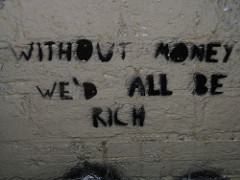This is a tale of two parking lots.
The parking lots are near a local hospital in downtown Dayton. One, perhaps more appropriately called a parking garage, is owned by the hospital. The lot immediately beside it is not. Both lots were usually about 80% full – quite a few of the hospital employees would choose to park in the private lot because it was so much closer than the (free, but distant) employee lot.
Then the hospital raised parking rates by 50%.
 The private lot, still charging the original rate, was constantly full. By 7am, there were no spaces available, and it stayed that way all day. That situation persisted for about four months.
The private lot, still charging the original rate, was constantly full. By 7am, there were no spaces available, and it stayed that way all day. That situation persisted for about four months.
Then the private lot raised their rate to match the hospital’s rate.
Now, the private lot is usually only 60% full on an average day.
This is basic math. When the lot was charging the basic rate (we’ll call it “x”), it was 100% full. So that’s 1x per day. Now that the lot is charging 1.5x, it is only 60% full. So that’s ( 0.6 * 1.5 * x ), or 0.9x . The lot is losing money, even though it’s charging a higher price. To maintain the same income level, it would have to keep the lot 2/3 full.
Interesting, right? Things get even more interesting when you talk about goods that do not have a finite supply. Like digital books.
The other day, Joe Konrath said that he had greater sales with cheaper eBooks. This makes even more sense than the lower rates for the car park. The car park can only rent as many spaces as they have available. It’s supply-driven through scarcity. I know that the lot was completely full all day when it had a lower rate than the hospital’s parking lot – but I don’t know how many more people would have paid if there were spaces available. It’s the idea of tapping into a broad market – the constraint is not supply, but demand.
Authors (and, in turn, publishers), want to maximize demand for our products. If you’ve found a good author, you’ll stick with them. So if you let more people discover your work – while paying you – then it will increase demand for future work as well. 1 So charging “regular price” for an eBook – especially back catalog from a producing author – is turning away potential profits from a much broader reader base. And that breadth might just be more profitable – both in the short and long run – than trying to milk a few suckers for the old idea of “full price”.
1 Yes, there is free software to read eBooks on a computer. And turning a netbook on its side actually makes a decent (multipurpose) eReader.

It occurs to me that the exact same arguments could be made for printed books. Because yes, if printed books were cheaper, they'd probably sell more copies too…
You're right – but I think that it's a potential game-changer for digital distribution. After my reply comment got to five paragraphs, I realized it should be a post… so it'll be up tomorrow. 🙂
I'm thinking about it too. I can see that $2.99 price point working for bringing out of print books back into "print". Heck, I was thinking about pricing Goldfish Dreams around $2.99 – $3.99.
But that's because the costs of producing that book have already been covered, broadly speaking. The physical materials and printing is part of those costs, but a small part. Meaning sure, we could hack prices on new e-books or print books, but who's getting cut out in those cases?
I'm still thinking it through myself, but I'm also a little concerned at reading about how (not from you, but elsewhere) $6.99 is just too much to pay for a newly-released e-book.